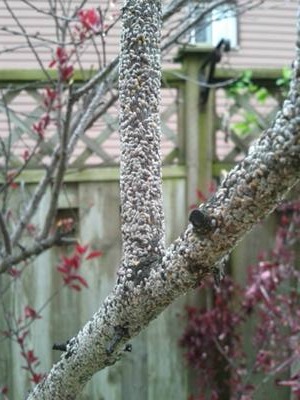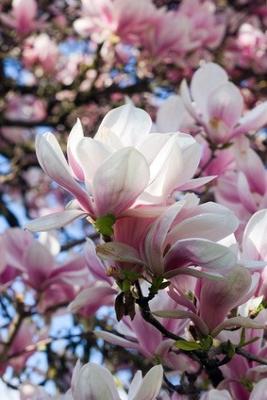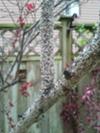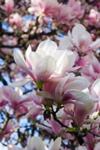Cherry Blossom Tree Problem
by Jennie
(Scarborough, Ontario, Canada)

Cherry Blossom Tree Problem
Question:
I have a cherry blossom bush that is growing these white scabs that clings to the tree bark and there's millions of them. Do you know what they are, and how to get rid of them?
I don't want to cut down the plant because it blooms with lots of flowers in the Spring. I live in Scarborough, Ontario, Canada.
I have included a picture of the problem. Thank you for your help.
Answer:
Hi Jennie,
Thank you for submitting the Cherry Blossom picture and the question.
Based on the research that I have done up to this point, I have not been able to identify the cause of the white scabs on your Cherry Blossom tree. The scabs could be a sign of infection, fungus, or some other internal problem.
The link below has information on diagnosing tree problems as well as helpful resources:
http://www.extension.iastate.edu/Publications/SUL3.pdf
You can find additional information on tree diseases at:
http://www.ag.ndsu.edu/pubs/plantsci/hortcrop/pp697-1.htm
Note - Just copy and paste the links into your browser.
You might want to consider consulting a professional arborist.
In addition, I have listed some common diseases and insects associated with Cherry Blossom trees.
Diseases
Black Knot
Black knot fungus typically affects branches and twigs; however, trunks can also show signs of this disease. Small, elongated, rough black swellings or knots develop on the woody portions of infected trees. If no treatment is administered, the infected tree can weaken over time and die. Fungicides can offer protection, as long as proper tree care is administered (pruning and sanitation).
Silver Leaf
This fungal disease is named for the silver luster of leaves that can occur – not all trees show signs of the silver foliage when infected. The first sign of this problem is twigs or branches dying off. Another sign of Silver Leaf is brown areas that appear in the middle and at the edges of leaves. At the first sign of Silver Leaf, remove and burn all infected branches, leaves, and twigs. Be sure to make the cut below the diseased area into healthy wood, covering pruning wounds with pruning sealer. There is no recommended chemical control to prevent or cure this disease.
Powdery Mildew
Powdery Mildew is a fungal disease that attacks the leaves and twigs of Cherry Blossoms. White patches appear on new leaves. Severely affected leaves will curl up and drop off. Destroy fallen leaves that have been infected. Treat this disease by spraying tree with a fungicide. Proper tree pruning can help to prevent the occurrence of Powdery Mildew.
Cherry Leaf Spot
Cherry leaf spot attacks the leaves and sometimes twigs and stems (usually in humid
Brown Rot
Brown Rot infects fruit, blossoms and small twigs and branches. Symptoms include blight, cankers and fruit rot. Cherry fruits shrivel up and become covered in a brownish substance. Brown, powder-like spores appear on the outside of infected flowers, fruit and/or twig surfaces Wind and rain spread the spores to uninfected parts of the Cherry Blossom tree. Remove and destroy all infected parts of the tree. Treat disease with a fungicide.
Bacterial Canker
The symptoms are similar to leaf spot; however, this disease is distinguished by the cankers that appear on the trunks, branches, and limbs. The cankers emit a gum-like substance. Dark brown spots appear on the leaves (sometimes surrounded by yellow), and can cause the leaves to wilt and die. Brown lesions appear on fruit, leaving a black impression on the skin. Remove and dispose of infected parts of the tree. Disinfect pruning tools since the bacteria can be transmitted to other trees. Treat with a fungicide that contains copper sulfate; be aware, fungicides that contain copper can cause injury to stone fruit.
Insects:
Black Cherry Aphids
These aphids are small insects (approximately 3mm long) that may or may not have wings. Leaves become stunted, twisted and curled. The Honeydew substance that is secreted by the aphids drips on the leaves, fruits and surrounding area. A black fungus grows where the honeydew has fallen. Spray the tree with an insecticide to kill the aphids.
Borers
Borers cause small holes, which ooze a gum-like sap, to appear in the trunk. Leaves and branches may turn brown, wilt, and die off. Borers attack weak, unhealthy trees. Proper tree care and fertilization can help discourage this pest. The tree trunk and branches can be sprayed with an insecticide. Consider consulting a professional arborist.
San Jose Scales
Signs of San Jose Scales include leaves that are light green or yellow and fall off, or brown leaves that remain into winter. The fruit might be covered with specks. Small, grayish bumps appear on the tree bark. If untreated, branches can eventually die. To treat this problem, spray the trunk and branches with horticultural oil in the spring when the tree is dormant.
I hope this helps. Please feel free to return and post a comment, give an update, or ask another question.
Warmest Regards,
Wendy








